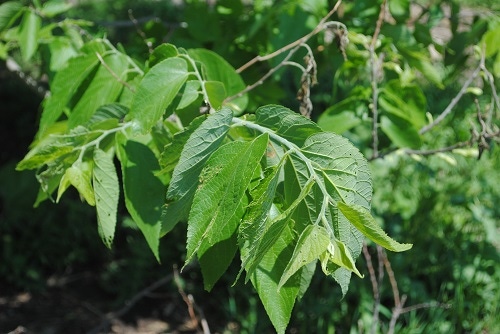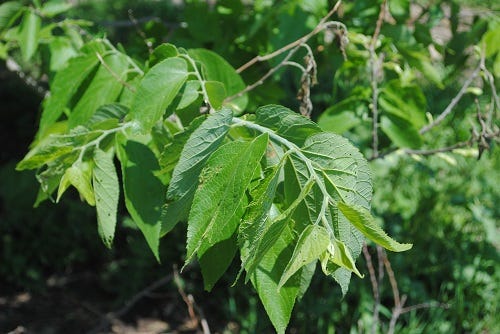
In this special Out on a Limb blog entry, I want to talk about a Nebraska tree that can be truly called native to our state. Hackberry trees are native to every zone in Nebraska. They are moderate to long-lived, with a lifespan that can stretch to 200 years, with leaves that are elm shaped and bark that is gray and has a rough, wart-like appearance. I know that prairie purists out there believe we shouldn’t be planting trees on the Great Plains. I know that our region was tall and short grass prairie in the days of the Lewis and Clark expedition.

However, when Mike Voorheis discovered the remarkable Ashfall Fossil Beds north of Royal, and began uncovering scores of intact ancient rhino skeletons that were buried in feet of ash from a volcano that erupted millions of years ago, he actually found fossilized hackberry seeds in the stomachs of those rhinos. So, in my mind, if hackberry trees were around back then, it passes the “native tree” test.
Hackberry trees are pretty tough, with a moderate growth rate and a tolerance to the harsh weather of the Plains. They are popular street trees in many of our rural towns and in shelterbelt plantings around our farmsteads. At maturity, they can grow to a height of more than 50 feet. While I’m a big fan of hackberry trees, they do have some susceptibility to nipple-galls on lower leaf surfaces. However, these gall insects rarely cause any major damage to the tree, but are unsightly.
It has been my experience that hackberry are also sentinel trees for herbicide spray drift. If located near crop fields that are sprayed regularly, they often will display impact from spray drift before any other trees. Lawn care herbicide products can cause problems for hackberry as well.
According to American Forests, the national champion common hackberry tree is located in Findlay County, Ohio, at a height of 88 feet and a crown spread of more than 89 feet. Nebraska’s champion hackberry located near Talmage is actually 90 feet tall with a crown spread of 86 feet.
Around our watershed along the West Bow Creek, we do not have the natural stands of bur oak, like streams that are closer to the Missouri River valley. But we do have natural stands of cottonwood, ash and hackberry. I love the prairie as much as anyone, but there is no doubt about the existence of native trees along ancient waterways and streams. If you want to plant a tree that it truly native to Nebraska around your farm or ranch, hackberry might be on your list.
Out on a Limb is a special blog entry each month aimed at improving on-farm forest and woodland management, discussing practical tools, tips and technology to help you manage your rural tree resources. Do you have hackberry trees growing around your farm or in your rural community? You can share your thoughts and experiences here.
Watch for all of your local farm news at Nebraska Farmer online, or follow us on Twitter at Husker Home Place.
About the Author(s)
You May Also Like






